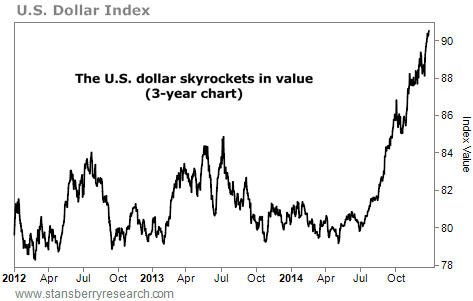| Home | About Us | Resources | Archive | Free Reports | Market Window |
This Bull Market Is NOT Over YetBy
Wednesday, December 31, 2014
The U.S. stock market boom is nearly six years old... But the fun ain't over yet!
Yesterday, I showed you how stocks could go much higher... even as interest rates finally rise. And today I'll show one more reason why this great bull market is NOT over yet...
This reason is extremely simple...
Stocks are not expensive yet.
Typically, in major stock market peaks, stocks reach "bubble" valuations before it's finally over.
We are simply not there yet.
Let me explain why...
The most common measure of stock market "value" is the price-to-earnings (P/E) ratio. Basically, high is bad and low is good.
Today, the stock market (the S&P 500 Index) trades at a P/E ratio of 18.3.
The long-term average P/E ratio is around 16... So stocks today are somewhat more expensive than normal... but they certainly aren't outrageously expensive. (Stocks are actually trading at a P/E of 16 based on 2015 earnings estimates.)
The thing is, you can't just look at the P/E ratio by itself... that doesn't give you enough information. You have to look at the current economic situation as well.
For example, the economic situation in 1980 – with high inflation and high interest rates – was much different than today. It's not "fair" to compare 1980 stock values with today's.
In our office, we use a simple metric to better compare apples to apples – we add the P/E ratio and interest rates.
You see, the level of interest rates has a lot of information built into it... It has inflation expectations... economic growth expectations... and whether or not the Fed is being accommodative (implementing policies to stimulate the economy) or restrictive (implementing policies to "cool" the economy).
The point is, we need to know what's going on with earnings AND interest rates to know what's really happening with stock valuations.
The chart below takes the P/E ratio and adds short-term interest rates. If the P/E is 10, for example, and short-term interest rates are 5%, our indicator shows a value of 15.
It's that simple. (We did smooth out a few nasty recessions that forced earnings to near zero on the P/E number.)
 Today, P/E ratios are slightly elevated, but interest rates are near zero. So compared with history, today's level shows stocks are STILL not expensive based on this measure. As you can see, stocks are a better deal today (in an environment of no inflation and low interest rates) than they were in 1980, when inflation and interest rates were in the double-digits.
The number 22 is the magic number for this indicator. When this indicator is less than 22, stocks return 12.3% over the next 12 months. But when it's more than 22... stocks fall over the next 12 months.
Today's reading is less than 19 – so we are not in a danger zone yet. And clearly we're nowhere near "bubble" valuations in U.S. stocks.
In short:
Rising interest rates won't kill the bull market in stocks, as I explained yesterday.
Stocks are not at bubble values, yet.
These conclusions might seem controversial... but they are simply based on the facts.
Yes, U.S. stocks have gone up for almost six years. But don't look backward... look ahead. And looking ahead at 2015, the U.S. is STILL an excellent place to put your money to work.
Don't let fear or emotions push you out of U.S. stocks. You want to own them in 2015!
Good investing,
Steve
Further Reading:
U.S. stocks are hitting all-time highs. But Steve says "buying at new highs has surprisingly been a winning strategy since the beginning of stock market history..." Find the proof here: The Myth About Buying at New Highs.
DailyWealth Classic: As you celebrate the New Year, keep Steve's "cocktail party indicator" in mind... "It'll save you a fortune by keeping you from following the crowd," he writes. Get all the details here: The Nearly Infallible Cocktail-Party Indicator.
Market NotesTHE VALUE OF YOUR CASH HAS SKYROCKETED Good news for savers: The value of your cash just skyrocketed.
From time to time, we show how your bank account's value is more volatile than you might think it is. Currencies like the U.S. dollar, Europe's euro, and Japan's yen trade on big financial exchanges just like stocks and commodities do. Most folks don't realize just how volatile currencies can be... and how their global purchasing power is affected.
The recent price action of the U.S. dollar confirms our point. Since mid-year, global investors have flocked to U.S. dollars because the currencies and economies of Europe and Japan are struggling... while the U.S. is doing relatively well.
You can see this "flocking" in the three-year dollar chart below. The dollar has climbed 12.5% in value since July. This is a huge move for a major currency in a short time... and a major increase in the global purchasing power of U.S. dollar bank accounts. It's great news for dollar savers.
 |
Recent Articles
|



